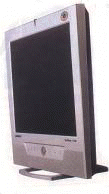| HOME
Technology 2003 Monitoring the monitors |
While the
computer and home entertainment experience has been escalating in
increments the screen technology enabling us to view all this innovation
has remained fairly mundane.
The trend is to bigger brighter, flatter, wider and thinner and away from the bulky cathode ray tubes (CRTs) which have traditionally delivered television and PC information to the eye. Until recently the majority of computers were sold with a 15 inch monitor not much different in size to the 14 inch clunky old green screen the first text-based PCs were delivered with back in the early 1980s. Now the 17inch screen optimized for high-end graphics is standard fare even on most low end PCs. A 17inch screen on its sells for around $400 - a third of what it was five years ago. There a strong upgrade market for those who have become used to larger screens art work and want more graphical space for their home machine even moving up the scale to a 19 inch or 21 inches of screen space. To upgrade from a 15-inch is only about $100. Estimate another $150 to scale up to a 19-inch monitor. Concurrently thereís a shift to more affordable pricing in flat screen and liquid crystal display screens for PC users. For a 17-inch flat screen monitor thereís a $100 or so premium. "This is still CRT-based but instead of the usual bug eye shape of the screen itís a truer flat screen. True flat monitors have a higher resolution or smaller pixel size giving a more stable image and making it easier on the eyes," says John Sims, Samsungís IT division sales manager. Samsung, which has had a direct presence in New Zealand for about a year, is the number one manufacturer of CRT and LCD monitors worldwide which are often re-branded by Dell, Compaq, IBM and Hewlett Packard. Now innovation from laptop level where everything has to be miniaturised for portability has resulted in a shift away from the CRT to thin film transistor (TFT). The massive drop in pricing of liquid crystal display (LCD) technology has seen a 15-inch monitor plummet to $800 - $1000 in recent months Ė about half what it was this time last year. So what are the advantages? With the 15-inch LCD screen you get an accurate 15-inch measure across the viewing area whereas the so-called 17-inch CRT only delivers 16 inches. "It takes a lot less of everything Ė less power is required, it takes up less space, thereís a more stable image, itís less strain on the eyes and thereís no radiation," says Mr Sims. At the high end of the market the price is still enough to make you blink twice and thatís where thereís likely to be savings in the future. Currently the 17-inch TFT is just under $2000 and the Samsung 24 inch screen for example is just under $10,000. Thereís also major shift in TV screens but still largely for those with discretionary income. The shift is away from the 30-inch or larger big screen tube or rear projection TVs to plasma and LCD screens that are thin and stylish. A 42-inch plasma screen still sells for around $16,000 although the LCDs equivalent would be $9-10,000. The futuristic dream is that viewing technology will become so flat and flexible youíll simply pull down a wall-sized screen whenever you want to watch your digital TV or DVD but we may have to wait a decade or more for that.. |